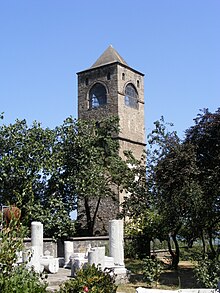| Revision as of 09:42, 16 July 2015 editCydebot (talk | contribs)6,812,251 editsm Robot - Moving category Former church buildings in Turkey to Category:Former churches in Turkey per CFD at Misplaced Pages:Categories_for_discussion/Log/2015_May_1.← Previous edit | Revision as of 11:55, 9 January 2016 edit undoNeoRetro (talk | contribs)Extended confirmed users1,139 editsNo edit summaryNext edit → | ||
| Line 5: | Line 5: | ||
| ] | ] | ||
| ] | ] | ||
| ] floor tiling as drawn by ] in 1864. What remains was covered with a carpet in 2013.]] | |||
| The former Church of '''Saint Sophia''' ({{lang-el|Ἁγία Σοφία}}, meaning "Holy Wisdom" {{lang-tr|Ayasofya}}), now the '''Saint Sophia Museum''', is a former Chalcedonian (]) ] located in the city of ] in the north-eastern part of ]. It dates back to the thirteenth century when Trabzon was the capital of the ]. It is located near the seashore and two miles west of the medieval town's limits. It is one of a few dozen ] sites still existent in the area. It has been described as being "regarded as one of the finest examples of Byzantine architecture."<ref></ref> | The former Church of '''Saint Sophia''' ({{lang-el|Ἁγία Σοφία}}, meaning "Holy Wisdom" {{lang-tr|Ayasofya}}), now the '''Saint Sophia Museum''', is a former Chalcedonian (]) ] located in the city of ] in the north-eastern part of ]. It dates back to the thirteenth century when Trabzon was the capital of the ]. It is located near the seashore and two miles west of the medieval town's limits. It is one of a few dozen ] sites still existent in the area. It has been described as being "regarded as one of the finest examples of Byzantine architecture."<ref></ref> | ||
Revision as of 11:55, 9 January 2016
Template:Other uses2 41°00′12″N 39°41′46″E / 41.00333°N 39.69611°E / 41.00333; 39.69611




The former Church of Saint Sophia (Template:Lang-el, meaning "Holy Wisdom" Template:Lang-tr), now the Saint Sophia Museum, is a former Chalcedonian (Greek Orthodox) church located in the city of Trabzon in the north-eastern part of Turkey. It dates back to the thirteenth century when Trabzon was the capital of the Empire of Trebizond. It is located near the seashore and two miles west of the medieval town's limits. It is one of a few dozen Byzantine sites still existent in the area. It has been described as being "regarded as one of the finest examples of Byzantine architecture."
History
Hagia Sophia was built in Trebizond during the reign of Manuel I between 1238 and 1263. The oldest graffiti carved in the apses of the church contain the dates 1291 and 1293. After Mehmed II conquered the city in 1461, the church was possibly converted into a mosque and its frescos covered in whitewash. Other scholars suggest it was not converted until 1584, being spared the initial transformation because it stood several kilometers outside the city walls. The monastery next door continued to be used by monks as late as 1701, when Tournefort found them still in residence. It is likely that the monks gradually abandoned a building that failed to protect them from harassment and predation, and the Turks assumed its use without needing to expel them.
During World War I and for a brief period afterward, the city was occupied by the Russian military and used as a makeshift hospital and depot. Afterwards it was put back into use as a mosque, until 1964 when it was turned into a museum - which it remains to this day. Between 1958 and 1964 the surviving frescoes were uncovered and the church consolidated with the help of experts from Edinburgh University and the General Directorate of Foundations; one expert involved in the work estimated no more than one-sixth of the original decorations had survived. All that did survive, however, are thought to be original works done just after its construction, and are considered part of the Byzantine 'Palaiologic Renaissance'.
The Hagia Sophia church is an important example of late Byzantine architecture, being characterised by a high central dome and four large column arches supporting the weight of the dome and ceiling. Below the dome is an Opus sectile pavement of multicolored stones. The church was built with a cross-in-square plan, but with an exterior form that takes the shape of a cross thanks to prominent north and south porches. The structure is 22 metres long, 11.6 metres wide and 12.7 metres tall. The late 13th-century frescos, revealed during the Edinburgh University restoration, illustrate New Testament themes. External stone figurative reliefs and other ornamenting is in keeping with local traditions found in Georgia and Armenia. 24 metres to the west of the church is a tall bell tower, 40 metres high. It was built in 1427 and also contains frescoes.
Mosque conversion
See also: Conversion of non-Muslim places of worship into mosquesIn 2012, the religious authorities (Diyanet) filed a lawsuit against the ministry of culture, claiming the ministry had been 'illegally occupying' the church for some decades. Diyanet won the case, getting ownership of the building. On 5 July 2013, the former church was partially converted for a while into a mosque according to the local Vakif Direction of Trabzon, which is the owner of the estate. The reconstruction works have already been started. Some frescoes were veiled and the floor covered by a carpet. The mufti of the Turkish province Trabzon said that “the works for opening the Hagia Sophia mosque in the city to practice prayers again are going on,” and that “during the prayer the mural paintings will be covered by curtains". The local union of architects from Trabzon filed a lawsuit against the ministry of religious affairs' conversion plan. A local judge ruled the transformation of the former church to be illegal, and ordered it to be maintained as a museum.
Cultural significance
The church figures prominently and has key significance for the author's spiritual development in Rose Macaulay's The Towers of Trebizond.
Gallery
See also
Notes
- "Religion in Turkey: Erasing the Christian past"
- Eastmond, Anthony. "The Byzantine Empires in the Thirteenth Century" in Art and Identity in Thirteenth-Century Byzantium: Hagia Sophia and the Empire of Trebizond. Burlington, VT: Ashgate, 2004, p. 1.
- Gabriel Millet, "Les monastères et les églises de Trébizonde", Bulletin de correspondance hellénique, 19 (1895), p. 428
- Millet, "Les monastères", p. 433
- Some details of the preservation can be read in David Winfield, "Sancta Sophia, Trebizond: A Note on the Cleaning and Conservation Work", Studies in Conservation, Vol. 8, No. 4 (Nov., 1963), pp. 117-130.
- Mosque conversion raises alarm
- Bartholomew I: Do not transform Hagia Sophia in Trabzon into a mosque
- Hagia Sophia to remain museum Kerknet, 6 November 2013
Further reading
- Eastmond, Anthony. Art and Identity in Thirteenth-Century Byzantium: Hagia Sophia and the Empire of Trebizond. Burlington, VT: Ashgate, 2004.
External links
- Hagia Sophia of Trabzon/Trebizond
- Other Christian Churches converted to Mosques
- Saint Sophia Trebizond
- Photos of the Hagia Sophia in Trabzon
- The Church of Hagia Sophia at Trapezounta, Pontos by Dr Constantine Hionides
- Buildings and structures completed in 1263
- Byzantine museums in Turkey
- Byzantine churches in Turkey
- Byzantine art
- Empire of Trebizond
- Museums established in 1964
- Byzantine architecture in Trabzon
- Greek Orthodox churches in Turkey
- Former churches in Turkey
- Cathedrals in Turkey
- Mosques converted from churches by the Ottoman Empire
- Museums in Trabzon Province




